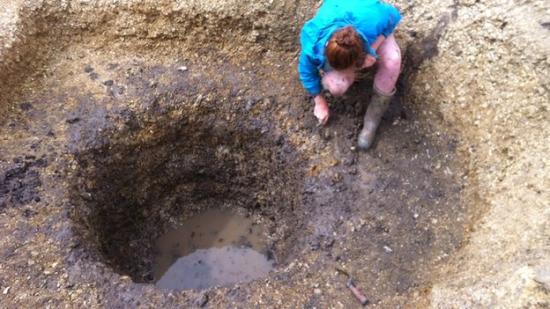Andrew Bomford
Source - http://www.bbc.com/news/uk-28795656

For 18 long summers, a quiet corner of Hampshire has resounded to the sound of tapping, scraping, and sloshing. But after Saturday all that will end.
Silchester - the site of one of Britain's longest running archaeological digs - has revealed many secrets since 1997.
It's thanks to the hard work of thousands of volunteers, students and staff from Reading University that we now know much more about Iron Age life, and the early Roman period around the time of the invasion of AD 43.
"It's been a great experience," said Professor Michael Fulford, who has directed the annual summer dig from the beginning.
"It's been particularly great to see so many generations of students coming through and starting their careers here."
Flourishing settlement
From the wooden walkway, erected for the hundreds of onlookers who turn up each year, you can look down on the excavation of Insula IX - the square Roman block - bounded from north-south and east-west by a 1m deep slice through old Roman roads.

Among the items found was this Roman soldier's toilet set, with tweezers, ear scoop and nail cleaner
Down at the Iron Age street level, about 5ft below current ground level, there are regular post holes and beam slots - the ghostly outlines of buildings long gone. Here and there are the remains of old wells - often the best places to find pottery, left there as offerings to the gods.
Prof Fulford showed me one of the most recent finds - the outline of a huge building, 50m long - the biggest example of an Iron Age house ever found in Britain.
"We've agonised about it as to what it is, but all the experts seem to agree. What else can it be but a great hall? This is unparalleled in Britain, which makes it very exciting, but it also makes it challenging because there's nothing to compare it with."
In Iron Age times Silchester was known as Calleva, and the team believe it was founded around the year 30 BC by Commius, or one of his descendants.
Commius was king of a northern French tribe called the Atrebates, based around the modern French town of Arras, in what was then known as Gaul. Commius fell out with Julius Caesar and fled to Britain.
By the time of the Roman invasion in AD 43, Calleva was a flourishing settlement; rather than establish a new base in the area, the Romans took it over, renaming it Calleva Atrebatum, and establishing their famous municipal order on the somewhat organic development of the earlier town.

A close-up the mess tin handle, just one of many other historical objects
Soldier's artefacts
Finds at the site show that even before the Romans, Calleva was plugged into a complex European community. The oldest olive stone ever found in Britain was discovered here, showing that olives and more exotic food stuffs like coriander were brought here long before the so-called civilising influence of the Romans.
Each year, during the six-week summer dig involving about 150 archaeology students and volunteers, about a third of a tonne of pottery is painstakingly dug up, washed, catalogued and examined. Just in the last few weeks several important finds have turned up.
A perfect example of a small Roman bowl was found in an old dung heap. There have also been rings and jewellery, with gem stones featuring Minerva, the goddess of wisdom, and Bonus Eventus, the god of fortune.
Dr Elise Fraser, the finds manager, showed me a couple of other fascinating objects. One of them looked like a metal bottle opener, but is in fact the copper handle of a Roman soldier's mess tin, and looks remarkably like something a World War One soldier would have used in the trenches.
"You can relate these objects very much to their modern-day equivalents. It just shows how little we've changed," she said.
The other item was part of a roof tile, with the stamp of the Emperor Nero on it - the only location they have been found in the whole of the Roman Empire.
"It's really exciting to find these things, because they are so rare," she said. Nine of them have been discovered so far at Silchester, and they suggest that Nero, who ruled Rome from AD 54-68, perhaps commissioned a building at Calleva.
"You won't find them anywhere else, just here. It's very strange and very unusual," she said.
"Why pick here? Out of all the places he could have chosen, why here? And that's an answer we just don't know."

This well is being scraped for possible artefacts
Abandonment mystery
On a more prosaic note, a regular find here are sets of tweezers, ear scoops and nail cleaners - part of a Roman soldier's toilet set, showing that when they weren't subduing the rebellious early Britons, a Roman soldier liked nothing more than to sit down and do some personal grooming.
Perhaps the most famous find at Silchester though was the bronze eagle, discovered during the Victorian period, and thought for many years to be part of an Imperial Roman standard.
It inspired Rosemary Sutcliff's book The Eagle of the Ninth, recently made into the Hollywood film The Eagle. These days it's believed to have been part of a statue, perhaps to the god Jupiter.
Prof Fulford and his team believe they've just about exhausted the site, and after Saturday the whole excavation will be filled in and returned to grassland. However another dig, focusing on the Iron Age period, is due to start nearby.
It leaves one of the biggest mysteries of all unanswered. Why, after 500 years of occupation, was Calleva abandoned?
"We just don't know," said Prof Fulford.
As the Romans might have put it, about the town as well as the dig: "Omnibus rebus bonis finis est" - all good things come to an end.